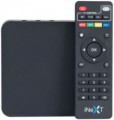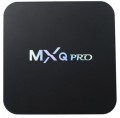Operating system
—
Proprietary system. The operating system of the device is represented by the proprietary software shell of the manufacturer. Usually, such operating systems have an attractive and convenient menu. A proprietary operating system is developed directly by the manufacturer for the hardware resources of a particular model or a whole line, but has limited capabilities.
—
Android (AOSP). This type of operating system is a modification of the popular Android OS, mainly notable for being open source. It is a versatile operating system that gives the user much more freedom to create changes and customizations within the system itself. At the same time, the installation and stability of certain applications on this platform are not guaranteed, and the overall system management was not specially “tailored” for large screens, which may cause some inconvenience. First of all, such solutions will interest users who understand the features of the Android OS, like to customize and control everything for themselves, and have time for this.
—
Android TV. Devices of this type have full-fledged Android TV software, specially adapted to work on large screens. In accordance with the name, it is a type of Android OS, specially designed for such equipment. In addition to the common features of all Androids (such as the ability to install additional applications, including
...even games), it has a number of special features: an optimized interface, integration with smartphones (including the ability to use them as a remote control), voice search, etc. Thanks to this, TVs with this feature are significantly superior in functionality to models with a “regular” Smart TV. Of course, a dedicated processor, graphics subsystem and memory are provided for the operation of a multifunctional OS, and the presence of such hardware resources is reflected in the overall cost.
— Google TV. Rebranding of the Android TV platform for TVs and smart consoles, or rather, a new shell on top of the operating system under the sign of the “green droid”, introduced since 2021. Among the innovations, it has a redesigned user interface, an improved knowledge base that more efficiently distributes content by genre and collects search information from the entire list of installed applications and subscriptions. The voice assistant now understands the needs of the audience better and provides a detailed list of what was found. A separate tab in the interface contains live broadcasts of current events, whether it be sports events or a rocket launch to Mars. Among other things, the aspects that involve the use of TV as a command post for managing a single ecosystem of a “smart” home have been improved in the system.AirPlay
The technology of broadcasting audio and video signals through a Wi-Fi connection. Widely used in Apple electronics, the media centre with AirPlay will make it easy to duplicate a “picture” on a TV, for example, from an iPhone or iPad. The main disadvantage of this technology compared to similar Miracast is the need for a local network with a wireless router.
Miracast
A wireless technology that allows you to directly broadcast video and audio from one device to another directly over a Wi-Fi connection. At the same time, unlike AirPlay, transmission does not require a router and building a local network — it is enough that the receiver and transmitter are compatible with Miracast. One of the most popular ways to use this technology is to output a “picture” from a smartphone / tablet screen to a TV, and vice versa.
A media centre or TV receiver with Miracast is useful if the TV itself does not support this function.
Coaxial output
In this case, the term
coaxial refers to a type of SP/DIF interface that uses an electrical cable with an RCA connector. This interface provides sound transmission, including multichannel, in digital format; at the same time, the electrical cable is more susceptible to interference than the optical one, but is not as fragile.
CPU frequency
The clock speed of the CPU installed in the media centre.
On the technical side, the higher this indicator, the faster the processor works and the higher, accordingly, the overall system performance. At the same time, the CPU performance depends, in addition to the frequency itself, on a number of factors — architecture, number of cores, special design features, etc.; and the actual speed of the entire system is affected by performance of components other than the processor. In addition, manufacturers usually select processors in such a way that their computing power is guaranteed to be enough for all the features claimed for a media centre. Therefore, in this case, the CPU frequency is more of a reference parameter (and partly an advertising indicator that demonstrates the advanced specifications of the device), rather than practically significant for buyer.
Ultra HD 4K support
The ability to play video in
ultraHD 4K on the device. This format covers several resolutions, all of which have a horizontal size of approximately 4000 pixels. However, the most popular is the frame size of 3840x2160 — in particular, this is the standard value for 4K TV screens; therefore, most UltraHD content is also released in this resolution.
A 3840x2160 frame contains 4 times more pixels than the popular Full HD standard, resulting in an even sharper and more detailed image. Of course, you will need a TV (or other screen) of the appropriate resolution to fully enjoy the experience; but such screens nowadays are becoming more common and affordable.
Video decoders
Codec — from the phrase "Encoder-DECoder" — in this case is the format used for encoding digital video during storage/transmission and decoding during playback (without encoding, video data would take up an unjustifiably large amount of space). Do not confuse this parameter with the format of video files: different files of the same format can be encoded with different codecs, and if the corresponding codec is not supported by the player, video playback will be impossible, even if the file format itself corresponds to the capabilities of the device. And in models with online TV support (see "Features") this nuance also determines compatibility with a specific broadcast: the general format of the broadcast is indicated by the codec used for this.
In general, modern devices usually have quite extensive sets of codecs (one of the most advanced for 2021 is
H.265), and there are usually no problems with video playback; in extreme cases, you can use special programs for transcoding files. As for specific codecs, detailed data on them can be found in special sources, but with standard use of media players, such details are not needed.
Audio decoders
The set of audio codecs supported by the device
Codec — from the phrase "Encoder-DEcoder" — in this case, the format used for encoding and compressing sound in digital form during storage/transmission and decoding — during playback (digital sound is basically impossible without encoding, and compression allows to reduce the amount of data). Information about supported codecs is relevant primarily for assessing whether the player will be able to work with sound in a particular video file. The fact is that even in video files of the same format (see below), sound can be compressed by different codecs; and if the player supports the file format, but does not support the codec, sound playback will become impossible.
Theoretically, these rules are also relevant for audio files and online broadcasts (all formats — TV, video, audio). However, in fact, when working with such content, you can ignore codec data. So, for each audio file format, usually, its own standard codec is used, and file type support automatically means codec support. Broadcasts usually use generally accepted audio decoders like MPEG-1 or MPEG-2, which are practically guaranteed to be supported by any modern player designed for such broadcasts.
As for specific codecs, detailed information on them can be found in special sources, however, with the standard use of devices, such details are usually not needed.

